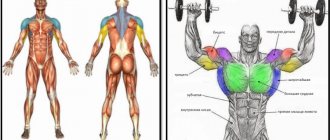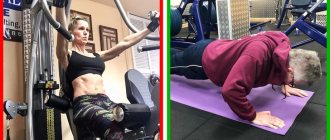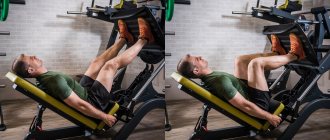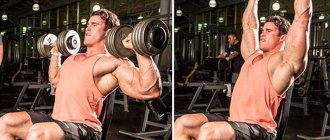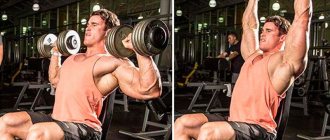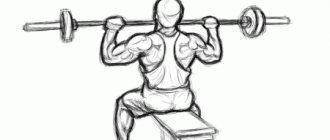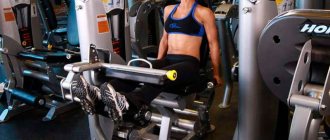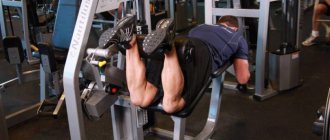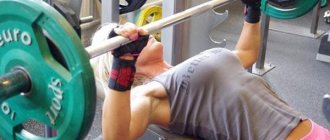Share:
Beautiful pumped up breasts are an important element in the figure of any athlete, be it a man or a woman. There are many effective ways to work this target muscle group. The dumbbell bench press is just one of these accessible methods. In the article we will tell you in detail how to do the dumbbell bench press correctly, consider different variations of the exercise (lying dumbbell press on a horizontal and inclined bench at an angle of 30-45 C), and suggest indicative programs and complexes for CrossFit using this exercise.
Advantages of exercising with dumbbells while lying down
By performing a dumbbell bench press, this allows you to perfectly increase the pectoral muscles. Although lifting a barbell is considered a basic exercise for developing the back, it will not help in the formation of a wide and beautiful chest.
Lying exercises with dumbbells are more effective than lifting a barbell for the chest muscles for the following reasons:
- The role of safety - exercises with dumbbells, especially those done with a neutral grip, place less stress on the elbow joints. The likelihood of injury is much less;
- Extended range of motion. The boundaries of barbell advancement are limited by the bar, but for a dumbbell these boundaries do not matter. They can be lowered low, which creates a greater stretch and contraction of the pectoral muscles;
- Ability to act without an assistant. Classes with dumbbells give beginners and pros the opportunity to work out their chests without the fear of being under a fallen barbell; dumbbells can easily be dropped to the floor if the weight is chosen more than necessary. It is considered the best exercise for women to pump up their breasts in the gym;
- Purposeful action. When lifting a barbell, 60% of the load falls on the chest, 20% on the triceps, and 15% on the anterior deltoid. When exercising with dumbbells, about 75% of the load is placed on the chest muscles. This makes these muscles grow faster;
- Number of options. The barbell lift has 1-3 variations, and dumbbell exercises have many more;
- Availability – The barbell lift is popular and the apparatus is often occupied. Dumbbells are always available and you can do them without being distracted by questions about the number of remaining approaches.
Contraindications
The dumbbell press can seriously aggravate an existing injury, or cause a new one. If you don't warm up before every workout, you may experience pain in your shoulders, hands, and elbows.
Regular neglect of preparation can cause serious tissue pathology.
If you experience the slightest pain in the joint area, you should stop exercising until complete recovery. The pain may be due to either muscle fatigue or tissue damage.
In the first case, everything will go quickly, perhaps the very next day. If the discomfort is persistent, it is advisable to consult a doctor immediately.
Technique for exercising with dumbbells while lying down
- You should take the dumbbells in your hands and support them with a neutral grip (palms facing you), then sit down on the bench. Next, the dumbbells are placed on your legs closer to your knees, and you should lean back, at the same time throwing the weight over your chest. At the beginning, it is worth unfolding the dumbbells in a single line so that they are on both sides of the chest, level with the collarbones. The legs rest on the floor, the lower back bends;
- As you exhale, with smooth movements without sudden movements, the dumbbells rise to the top. In the upper position, you need to linger for a few seconds, tense your chest muscles and lower the dumbbells to the floor more slowly than you did the lifting. Slowly place the projectile in its original position.
Before doing exercises, it is important to warm up to prepare the body for heavy loads.
Common mistakes
- No warm-up
The muscles and joints are not prepared for hard work, which will sooner or later lead to injury.
- Performing a one-arm press
The spine is overloaded, which can lead to injury.
- Improper breathing
Don't hold your breath. Muscles need a constant supply of oxygen.
Raise the weight as you exhale and lower it as you inhale. If you breathe in reverse, intra-abdominal pressure will increase (leading to hernias), and the muscles will not be able to contract properly.
- Snatches, cheating, walking elbows and back
Elbows should move strictly in a vertical plane. Walking elbows reduce the effectiveness of the exercise and increase the risk of injury.
Keep your body vertical so as not to overload your spine. There is a little secret to keep your back straight. You need to look forward or even a little up. If the body is rocking back and forth, reduce the weight of the projectile.
- Overtraining
The deltoids work not only on the day of shoulder training, but also on the day of chest training. Therefore, they can easily be overtrained and damaged. In order for deltas to grow, you need to give them proper rest.
Finally, watch these videos to fully understand the exercise.
Seated dumbbell raises
Many experienced bodybuilders consider the seated dumbbell press exercise to be the best core exercise for pumping up the shoulder muscles. In this action, you will be pleased with the large amplitude that loads the delta areas.
This exercise allows you to take on large weights. Before training, you need to warm up thoroughly.
The training steps are as follows:
- First, you should set the angle of the bench, which should be 60-90 degrees.
- Place the dumbbells on the floor and sit on a bench.
- Having made a small jerk, the dumbbells are thrown to shoulder level. This will become the starting position.
- Exhaling, raise your arms until the dumbbells are near each other in the upper segment, but you must not allow them to touch.
- Slowly lower the dumbbells, while spreading your elbows to the sides, bringing the projectile to the line of your earlobes.
- You need to contract your shoulders in the lower position and raise the dumbbells up again, the shoulders contracting in the upper position.
- Repeats are done as many times as necessary.
During this action, it is important to make sure not to hit the dumbbells in the upper position, because this will remove the load from the deltoids.
Breast
We can say that the exercise was invented specifically for this area. The classic version has already been disassembled, now we need to explain how the voltage is redistributed when the operating angle changes.
The standard, horizontal position distributes the work evenly over the entire area, but since the central zone contains most of the fibers, it eventually begins to dominate over the rest.
To correct the injustice, you need to change the angle of the bench. The higher the shoulders are above the level of the pelvis, the more tense the upper bundles are, the lower, the more tense the lower ones.
To avoid the appearance of imbalance in the figure, it is advisable to combine angle changes during chest training.
Incline dumbbell raise on a bench
The dumbbell bench press allows you to pump up all areas of the chest. To fully engage the top, middle and bottom of the pectoral muscles, you need to perform exercises from different angles.
An inclined dumbbell press differs from a transverse one in the angle of inclination of the backrest and in the movements of the athlete. It is done at an incline of 30-45 degrees, it is often done after the main bench lift.
Here are the details of the lesson:
- Due to the fact that the athlete is not lying horizontally, he will roll down. To prevent this, you need to slightly raise the edge of the seat;
- Up and down actions are done strictly along a vertical line. Due to 30 and 45 degrees, the loaded area of the chest changes;
- Your feet should be placed wider than on a cross bench. Due to this, the athlete will sit more stable;
The exercise is done in 3-4 approaches, repeating 10-12 times.
Features and benefits of the exercise
Fitness instructors consider performing a dumbbell bench press while lying on an inclined and horizontal bench a much more suitable basic exercise for a beginner than the same thing, but with a barbell. This is due to the following features:
- There is no point in picking up a barbell unless you have basic skills in the technique of working with it. The muscles simply cannot contract as they should.
- Two projectiles weigh significantly less than even an empty bar (the so-called Olympic weight is 20 kg).
- Efficiency in “clogging” muscles. At the end of a heavy strength training session, “squeezing out the last bits” of yourself with the bar becomes an impossible task for many. With the help of dumbbells, the chest, shoulders, and triceps are qualitatively improved.
- The hand squeezes the projectile autonomously, without interfering with the other to work with the required amplitude. More force is expended to hold them, and stabilizer muscles are more actively involved in the process.
The benefits of the dumbbell bench press are:
- these equipment are much less popular among practitioners than the barbell - you don’t have to wait your turn;
- no spotter is required - it is impossible to press yourself to the bench with dumbbells;
- the range of movements is greater;
- minimal risk of injury to the elbow and shoulder joints due to the naturalness of movement.
You can pump up your pectoral muscles with dumbbells even at home, having first mastered the technique. Purchasing a bar, “pancakes”, locks and a stand for it is not an option that suits everyone. Dumbbells are cheaper and more mobile.
Free access
No belayer required
Large range of motion Minimal risk of injury
Standing Dumbbell Raise
Let's look at the standing dumbbell press technique. To warm up the body, you need to perform exercises with light weights. It should be mentioned that classic dumbbell lifting involves working with light weights.
Here's how it's done:
- Feet are placed shoulder width apart. The dumbbells are taken with an overhand grip, then raised to head level. Palms are turned forward. The arms are bent at the elbows at a right angle.
- After inhaling, you need to keep your body motionless, your arms straighten above your head along the trajectory of a triangle, but your elbows do not straighten here.
- After exhaling, you need to hold on and return to your original position without haste.
Recommendations[edit | edit code]
Be careful when approaching the dumbbell bench press, learn to maintain control of it before you begin intensive work with progressive weights, and the dumbbell bench press will serve you well. However, do not forget that the dumbbell bench press is not the only alternative to the barbell bench press. If the bench press racks at your gym are always full and you can't reschedule your workout, you can switch to parallel bars. This assumes that your gym has decent dip bars and that you are strong enough to do them. If done with good form, push-ups can be a safer and more practical exercise than the dumbbell bench press—at least for most people. Or you can do barbell presses on a bench with a slight incline.
French press
The French press with dumbbells allows you to train your triceps. In a sitting position, the exercise is carried out on an inclined bench, the back is set at a right angle.
Actions for implementation are as follows:
- Two dumbbells are turned around so that the circles are in front and behind, and your hands should be placed palms facing each other.
- The dumbbells are raised above the head with the arms slightly bent at the elbows. You need to try to make the angle of the shoulder in relation to the floor 90 degrees.
- The arms should be bent at the elbow joints so that the shoulder does not move to the sides. The dumbbells are placed behind the head until an acute angle is formed at the elbows.
- The weight is raised to its original position.
First, 10 repetitions are performed to warm up with a light weight, then the working weight is taken and 3-4 sets of 8-10 repetitions are done.
It is advisable to make sure that your elbows do not move to the sides.
What muscles work
The dumbbell press gives the main load to the pectoralis major and minor muscles. It “shifts” if you change the position of the body:
- horizontally, the middle part of the chest is loaded as much as possible;
- when pressing dumbbells at an angle, it depends on the position of the head - in its natural form, the top works more, if you turn over, the bottom works more.
The anterior deltoids and triceps are somewhat less loaded. Stabilization of the body is provided by the muscles of the back (latissimus), abdominal press (abdominal), and buttocks. Maintaining the required immobility is more difficult than it seems, so they work and strengthen quite actively. The “stability” of the shoulders is very important when pressing. The serratus anterior and pectoralis major muscles are “responsible” for it, and the rhomboid and partially trapezius muscles on the back. The movement of the shoulder joints of the required amplitude is provided by the rotator cuff muscles and the biceps brachii muscle.
A position tilted at an angle of 30 degrees upward is more convenient in terms of maintaining balance than the horizontal position.
Photo of dumbbell press (sitting, standing, lying)
Shoulder anatomy
In an anatomical sense, the shoulder muscles include all muscle tissues that are located from the neck to the elbow joint.
I have already written a detailed article on the blog, where I described the anatomy of the shoulders, be sure to read it!
To put it simply, the shoulder refers to the area of the body from the neck to the arm - in anatomy it is called the shoulder girdle.
The main muscle that determines the appearance and functionality of the shoulder is the deltoid muscle (deltoid).
It consists of three parts or bundles (heads):
- anterior or clavicular part;
- middle or acromial part;
- posterior or spinous part.
The anterior bundle is responsible for flexion, adduction and abduction, retroversion, internal rotation (rotation) of the shoulder, the posterior one is responsible for extension and external rotation, abduction and adduction, and the middle, most massive one is for abducting the shoulder and holding it in this position.
It is extremely important to pump up your shoulders, because... it adds a very cool look to your body and makes your figure V-shaped on top.
Working on the development of deltoid muscles or deltas allows you to:
- it is advantageous to highlight the size of the biceps and triceps;
- make the hand more prominent;
- visually expand the width of the shoulders;
- improve the results of exercises on other muscles in which the deltoids act as assistants.
To develop the deltoid muscles, the seated dumbbell press exercise is often used.
It belongs to the basic ones, since it is multi-joint and, accordingly, in addition to the delta, other muscles are worked out when performing it.
By the way, read my article about types of physical exercise if you haven’t already.

